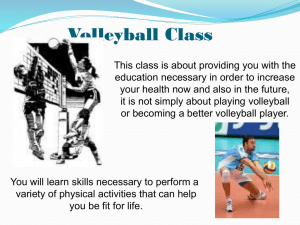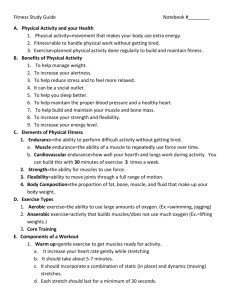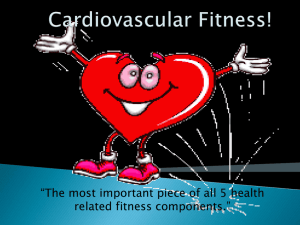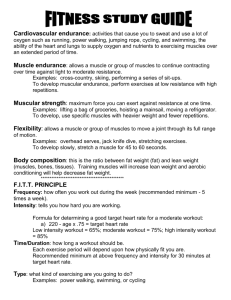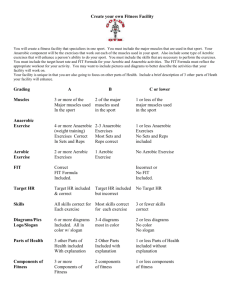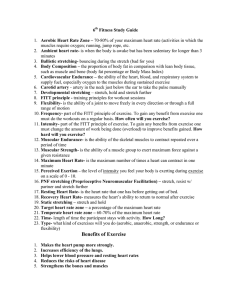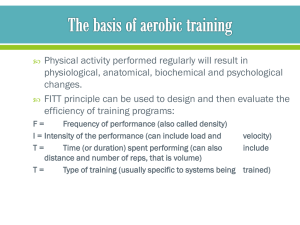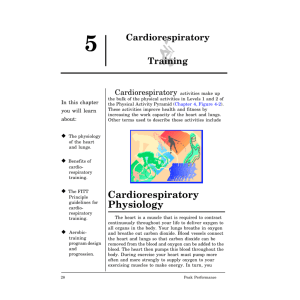FITT Principle Lecture fitt_principle_lesson1
advertisement
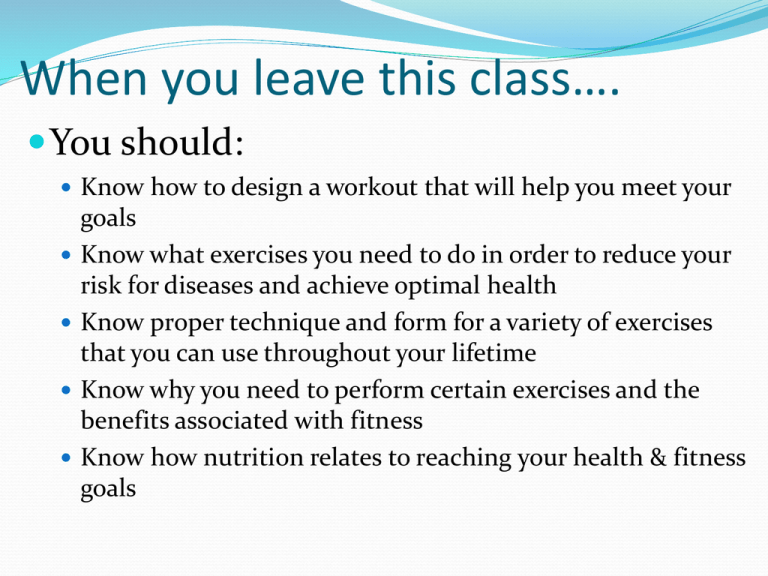
When you leave this class…. You should: Know how to design a workout that will help you meet your goals Know what exercises you need to do in order to reduce your risk for diseases and achieve optimal health Know proper technique and form for a variety of exercises that you can use throughout your lifetime Know why you need to perform certain exercises and the benefits associated with fitness Know how nutrition relates to reaching your health & fitness goals EXERCISE & PHYSICAL ACTIVITY Physical Activity: any movement that works the larger muscles of the body, such as arms, legs, and back muscles. Basically, not being sedentary (very little movement). Exercise is physical activity that is planned, structured, and repetitive, that results in improvements to your health and fitness level How Much Exercise? AEROBIC EXERCISE Do moderately intense cardio Moderate-intensity aerobic activity-means you're working hard enough to raise your heart rate and break a sweat. One way to tell is that you'll be able to talk, but not sing the words to your favorite song. 30 minutes a day, five days a week Or Do vigorously intense cardio 20 minutes a day, 3 days a week Vigorous-intensity aerobic activity means you're breathing hard and fast, and your heart rate has gone up quite a bit. If you're working at this level, you won't be able to say more than a few words without pausing for a breath. Two Types of Exercise Cardiorespiratory or Aerobic Exercise Continuous activity in which the heart can supply all the oxygen the muscles need. Heart rate remains elevated for a period of time (usually over 15 min). Examples: jogging, swimming, cycling, etc. Resistance Training or Anaerobic Exercise Physical activity done in short, fast bursts in which the heart cannot supply blood and oxygen as fast as muscles use it. Activity that cannot be sustained for a long period of time. Examples: weight-lifting, sprinting, calisthenics (push-ups, sit-ups, jumping jacks, etc.) The FITT Principle The FITT principle provides a framework you can follow for developing an effective exercise program. This principle allows you to design a routine that ensures that you are going to achieve a high level of physical fitness by including all the necessary components of fitness. You are more likely to benefit from exercise if it is designed to meet specific goals and includes at least the minimum amount of recommended exercise. The FITT Principle F: Frequency is the number of times you exercise each week. I: Intensity is how hard you are working while you are exercising. (The effort you put forth.) T: Time is the total amount of time that is spent exercising in one session. T: Type is the type of exercise you are doing—cardio or resistance training. Aerobic or anaerobic exercise. Cardiorespiratory Endurance Frequency- exercise 3-5 times per week Intensity- train at 60-85% of one’s maximum heart rate Time- 20-60 minutes per session Type- any aerobic activity that keeps heart rate within your target heart zone Examples: Jogging, swimming, cycling, playing basketball or soccer, step aerobics class, etc. Benefits of Doing Cardio Physical Benefits: Makes the heart a more efficient pump, reducing the risk of heart diseases. Lowers blood pressure. Helps to burn fat and control body weight. Increases lung capacity Mental Benefits: Improves regulation of stress hormones (feel less stressed) Improves blood flow to the brain, allowing a person to be able to think better Improves mood—reduces the risk of depression Your Heart is a Pump Resting Heart Rate Excellent (elite athlete) Below 50 bpm A well-conditioned athlete Around 60 bpm Average resting heart rate Men=60-80 bpm Women 70-90 bpm Sedentary (poor fitness) Over 100 bpm Finding Target Heart Rate Zone A simple way to determine your maximum heart rate is to use the following formula: 220 - age = Maximum Heart Rate Maximum Heart Rate An example for a 15 year old person would be as follows: 220 – 15 = 205 205 x .60 = 123 205 x . 85 = 174 Target Heart Rate Zone 123 – 174 This range is what a 15 year old should work at in order to improve cardiorespiratory endurance. How Much Exercise? RESISTANCE TRAINING •Do 8 to 10 strength-training exercises, working different muscle groups •At least 8 to 12 repetitions of each exercise twice a week. Push-Ups Dips Wall Sits Lunges Curls Pull-Ups Sit-Ups Benefits of Resistance Training or Anaerobic Exercise Builds and tones muscles, increases the strength and density of bones Increases muscle mass—which helps to maintain a healthy metabolism Reduces chances for muscle deterioration later in life and less chance of muscle injury Improved sport performance Improved resistance to fatigue Muscular Endurance Frequency-weight train 2-4 times per week Intensity- workout so that you are lifting a weight appropriate for 8-20 repetitions, with little rest time in between lifts Time-a total workout can be about 30-60 minutes (allows enough time to perform 8-10 different exercises about 8-15 repetitions.) Type-an activity that allows the muscles to perform a physical task over a period of time without becoming fatigued (resistance training, Pilates, circuit training, etc.) Flexibility The range of motion that is possible around a joint or joints. The skeletal muscles of the body will shorten over time as a result of poor posture and lack of activity. Proper stretching works to restore the flexibility of a joint by elongating the muscles surrounding the joint. Increased range of motion reduces risk of injury and allows for better athletic performance Flexibility Frequency- daily stretching Intensity- stretch muscles and hold beyond its normal length at a comfortable stretch (hold to tension, not pain) Time- hold stretch for 10-20 seconds . The stretching workout lasts as long as it takes to stretch all the different muscle groups. Type- use stretches that allow the body to move through the full range of motion. Yoga. http://www.swiftclas sroom.com/teachers/ ncalkins/index.php
